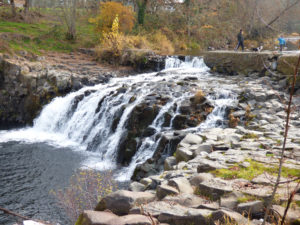Oregon’s dams are a part of an important story according to Ron Garst, the Natural Resources Representative for the Pudding River Watershed Council (PRWC). And the 150-year-old dam in Scotts Mills Park is no exception.
“This is a history lesson,” Garst said, noting that defunct dams, like the one in Scotts Mills, are a record of the often-wanton use of natural resources during the late 19 Century.
“It’s a remnant piece of the way people responded to the area and the attractive way they used natural resources at the time,” he said, adding, “What I hope the social piece for younger generations is, is that we’re recognizing our responsibility to be good stewards of the land and taking action.”
That’s where organizations like the PRWC come in. Community-based and grassroots, the PRWC is one of many groups looking at these older dams constricting the state’s rivers and determining ways to create better fish passages.
“But we’re not government,” PRWC’s Executive Director Anna Rankin, stressed. “We work with the government. They partner with us.”
One of those partnerships is with the Oregon Department of Fish and Wildlife (ODFW), which has, along with the Oregon Watershed Enhancement Board (OWEB), conducted studies during the past five years to determine the effect the Scotts Mills Dam is having on the numbers of juvenile fish found in Butte Creek.
“As a result of this watershed assessment, it identified that there were more fish below the dam than they would expect,” Rankin verified.
Originally built between 1860 and 1870, to power both a saw mill and grist mill for the Scott brothers, the dam was not originally outfitted with a passageway for the native fish – cutthroat trout, winter steelhead, lamprey and spring chinook salmon – to move from one end of the stream to the other. In fact, it was not until its purchase, many years later, by Portland General Electric, that any effort was made to remedy the problem by adding a “fish way.”
“It’s not a highly functioning fish
ladder,” Garst said, adding that
even if it were, fish ladders are often
not a sufficient remedy to the problem dams create.
The other problem the Scotts Mills Dam poses to the fish habitat is the buildup of sediment that a century and a half of constriction has created.
“If you stand behind the dam you will see sand and gravel,” Rankin observed. “It’s all filled up.”
But even with the scientific evidence gathered by the PRWC and its partners, removal of the dam has met a fair share of disapproval that has taken the PRWC years to overcome.
“There is a voice of opposition,” Rankin acknowledged. “Four years ago, when I took this proposal to Scotts Mills some of the council and the residents were opposed.”
But that all changed when, on Oct. 2, Rankin presented another proposal – citing the dam’s crumbling concrete and boulder barrier, exposed and rusting rebar and stagnant pools, all potential dangers to the visitors of the park.
“The best restoration stories are told when communities come together to conserve their natural resources,” Rankin wrote. “We recognize that the Scotts Mills County Park brings a lot of visitors to the community every summer and we are pursuing the removal of the dam with the intention to be not only good for fish, but also benefit of community.”
The proposal was approved.
“This dam has been deteriorating over several years, and while it is not the City’s property, we as the city recognize that the dam is no longer serving its original purpose and has not been maintained in a way that is conducive to it remaining,” Scotts Mills Mayor Paul Brakeman wrote in his letter of approval.
“If the dam were to be left as it is it would eventually fail on its own and cause damage to our community,” he added. “The dam has also had a detrimental effect on the fish habitat that once flourished in our region.”
After the dam’s removal – slated for the low-flow period in early September 2020 and which should in no way affect property owners downstream – Brakeman hopes that a monument will be erected in honor of the structure’s historical significance, an idea Garst applauds.
“There could be a little kiosk that tells two stories,” Garst suggested, “the story of the fish and how the settlers used the surroundings.”
In the meantime, plans for the dam’s removal are going forward, with funding requests posed to both the ODFW and OWEB.
“We submitted the proposal and have got six months before we know if we are funded,” Rankin said. “And between now and April the OWEB will do their review. The goal is to go into deconstruction after Labor Day. But all of this is contingent on whether or not Marion County gives us permission. And it would be ideal for Marion County to partner and do some of this work.”
Although the removal of the dam should be relatively quick – the group hopes to have it completed by October – the natural repair of the river itself will be much slower.
“Slow and long-term,” Garst emphasized. “What we’re doing is making the habitat more accessible for native fish. Spawning and rearing in the lower reaches will be improved.”
And river usage by swimmers and fisherman should go unchanged.
“The swimming hole won’t go away because the cascading bedrock is still there. In fact, I think the park in its natural state is going to be a beautiful place to be.”
